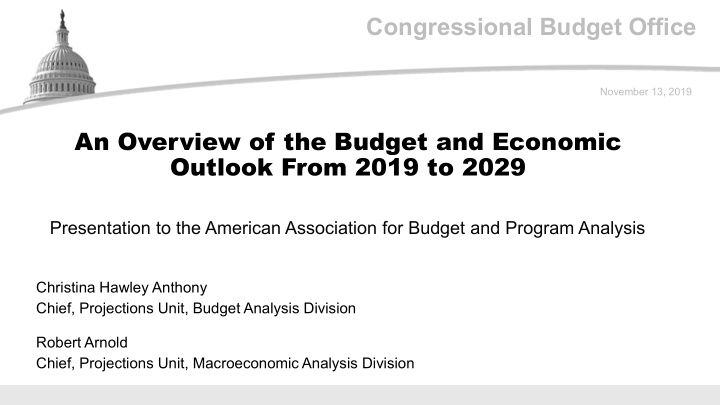



Congressional Budget Office November 13, 2019 An Overview of the Budget and Economic Outlook From 2019 to 2029 Presentation to the American Association for Budget and Program Analysis Christina Hawley Anthony Chief, Projections Unit, Budget Analysis Division Robert Arnold Chief, Projections Unit, Macroeconomic Analysis Division
CBO CBO’s Role in the Budget Process To provide the Congress with objective, nonpartisan, and timely analyses of legislative proposals and of budgetary and economic issues to support the Congressional budget process 1
CBO CBO’s Process for Developing the Budget Baseline 2
CBO The Baseline The baseline is a benchmark for measuring the budgetary effects of proposed changes in federal revenues or spending. It is not a prediction of future outcomes. It is based on the assumption that current laws and policies generally remain the same. It incorporates CBO’s economic projections, which are also based on current laws and policies. 3
CBO How the Baseline Is Constructed The principles and rules mainly come from law, budget resolutions, House and Senate rules, and the 1967 Report of the President’s Commission on Budget Concepts . A key law is the Balanced Budget and Emergency Deficit Control Act, section 257. It defines the baseline: “The baseline refers to a projection of current-year levels of new budget authority, outlays, revenues, and the surplus or deficit into the budget year and the outyears based on laws enacted through the applicable date.” It sets out rules for projecting spending and receipts. It requires an assumption of full funding for entitlements. It specifies the treatment of expiring programs and certain excise taxes. 4
CBO How CBO and the Congress Use the Baseline The baseline is a neutral benchmark for measuring the budgetary effects of proposed changes in federal revenues and mandatory spending. It serves as the basis for: Cost estimates for proposed legislation CBO’s analyses of the President’s annual budget CBO’s volume of policy options that would reduce the deficit Other reports (including those describing CBO’s long-term budget projections) Assessments of historical and projected trends in the budget It is often a starting point for budget resolutions. 5
CBO CBO’s Current Economic Projections 6
CBO Growth of GDP and Potential Real GDP GDP = gross domestic product. 7
CBO The Output Gap 8
CBO The Unemployment Rate and the Natural Rate of Unemployment 9
CBO The Labor Force Participation Rate 10
CBO Inflation PCE = personal consumption expenditures. 11
CBO Interest Rates 12
CBO Factors Underlying the Growth of Potential GDP 13
CBO CBO’s Current Budget Projections 14
CBO Total Deficits and Surpluses 15
CBO Total Revenues and Outlays 16
CBO Changes in Projected Revenues From 2019 to 2029 * = between zero and 0.05 percent of gross domestic product. 17
CBO Changes in Projected Outlays From 2019 to 2029 18
CBO Total Deficit, Primary Deficit, and Net Interest 19
CBO Federal Debt Held by the Public 20
CBO For More Information The projections presented here were first published in Congressional Budget Office, An Update to the Budget and Economic Outlook: 2019 to 2029 (August 2019), www.cbo.gov/publication/55551. 21
Recommend
More recommend